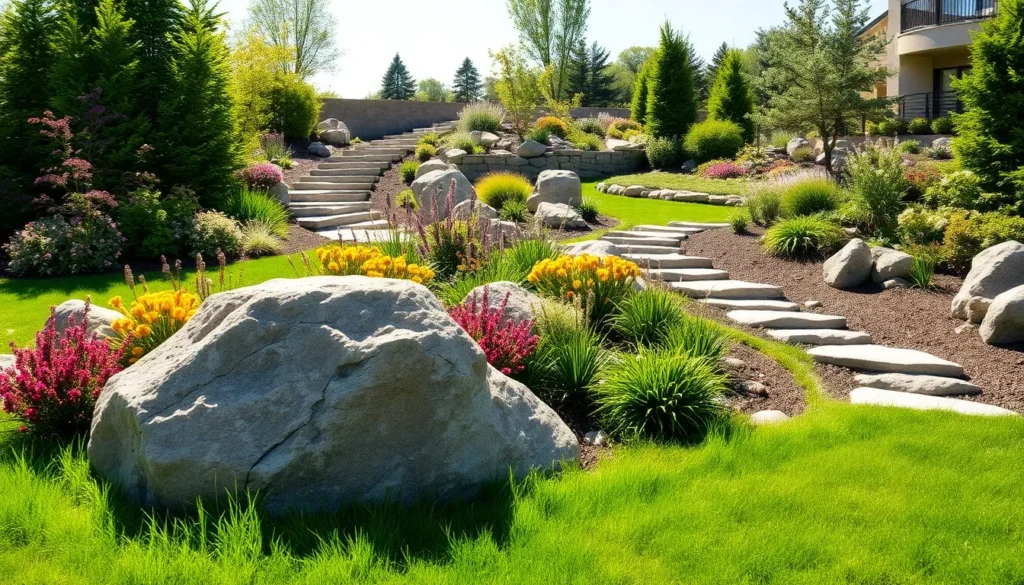Table of Contents
TogglePicture this: you open your back door, step outside, and are greeted by an outdoor paradise that makes you feel like you’ve just wandered into a stunning nature show. With boulder landscaping, this could be your reality. Not only does it add beauty, but it also provides various benefits like creating a low-maintenance garden and enhancing your home’s curb appeal. This article will jump into how boulders can transform your outdoor space, and yes, you might just find yourself sneaking a boulder (or two) into your landscaping plans. Let’s roll.
Understanding Boulder Landscaping

Boulder landscaping refers to the strategic use of large stones as an integral part of outdoor design. In contrast to traditional landscaping methods that often rely heavily on plants, boulders introduce earthy elements that create harmony and elegance in outdoor spaces. These natural stones can serve various purposes, including acts as focal points, creating borders, or even acting as functional seating areas. By incorporating boulders into gardens, yards, and pathways, homeowners can achieve a unique aesthetic that connects with nature. Also, they are incredibly versatile, fitting seamlessly into a wide variety of themes, from rustic mountain retreats to sleek modern designs.
Benefits of Using Boulder in Landscaping
The benefits of incorporating boulders into landscaping are numerous. For starters, they require minimal maintenance, unlike traditional plants that need regular tending to thrive. They can withstand fluctuating weather conditions without significant wear, making them a wise investment. Also, boulders can enhance drainage in your yard. By strategically placing them, you can direct the flow of rainwater, preventing pooling and potential flooding. Let’s not forget about aesthetics. Boulders add a unique texture and visual interest that plants alone can’t achieve. Whether it’s creating a serene rock garden or a dramatic centerpiece, boulders bring depth to any landscaping project. They boost property value too, homes with attractive landscaping often sell faster and for more.
Types of Boulder Landscaping Designs
There are several design styles involving boulder landscaping. One popular approach is the rock garden, where soil is combined with a variety of stones, plants, and grasses. This creates a visually appealing, layered effect. Another common use is in retaining walls, which help control erosion while adding visual appeal. Water features, such as streams or ponds, also benefit from boulders, framing the edges or serving as natural filters. Finally, pathways made from flattened boulders create natural-looking walkways that blend beautifully with the surrounding environment. Each design offers a different way to incorporate the beauty of boulders while serving practical landscaping needs.
Choosing the Right Boulder for Your Project
Selecting the right boulder for your landscaping project can seem daunting, but it doesn’t have to be. First, consider the size: larger boulders can make a bold statement while smaller ones offer delicacy. Next, think about the color and texture, some boulders are smooth, while others boast rugged surfaces. These attributes influence how the stone will fit within your landscape. Local sourcing can also play a role: choosing boulders that naturally occur in your area ensures better blending with the environment. Finally, budget matters. Investigating different suppliers and options like reclaimed stones can save money while maintaining quality.
Installation and Maintenance Tips
Installing boulders in landscaping is not as arduous as it sounds, but proper planning can save time and effort. First, identify strategic locations for the boulders. This might include areas where they can act as natural borders, focal points, or drainage aids. Heavy lifting equipment could be necessary for larger boulders, so consider hiring professionals for installation. Once installed, maintenance primarily involves keeping them clean. A simple rinse with a hose can prevent algae build-up. Besides, inspect the surrounding area regularly to ensure no plants or weeds are overtaking your boulders.
Common Mistakes to Avoid
While incorporating boulders into landscaping, several pitfalls can derail your vision. One common mistake is choosing boulders that clash with the surrounding environment: ensure they complement the existing landscape. Another error involves poor placement. Boulders should appear naturally integrated, not merely dropped into the yard. Also, overuse can overwhelm an area, scatter them thoughtfully rather than grouping them excessively. Finally, neglecting water flow can lead to unsightly stagnation. Always consider how water moves and flows when planning your boulder placement.




